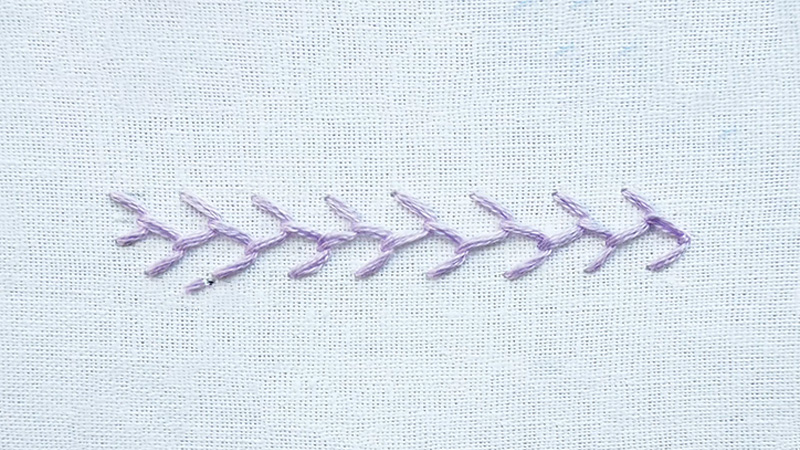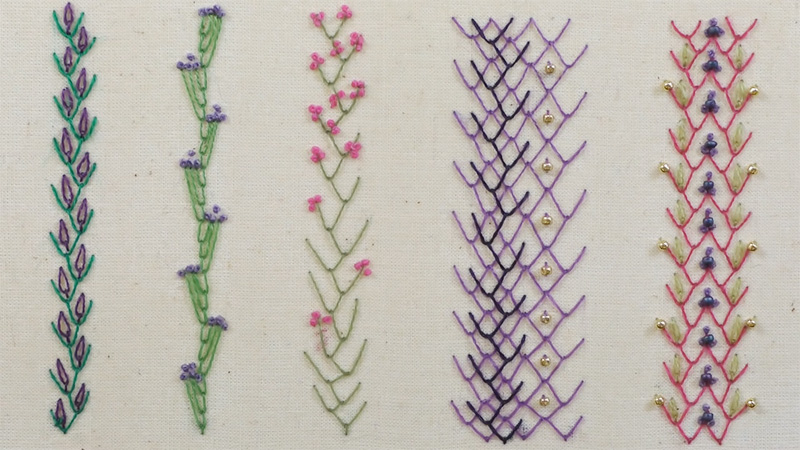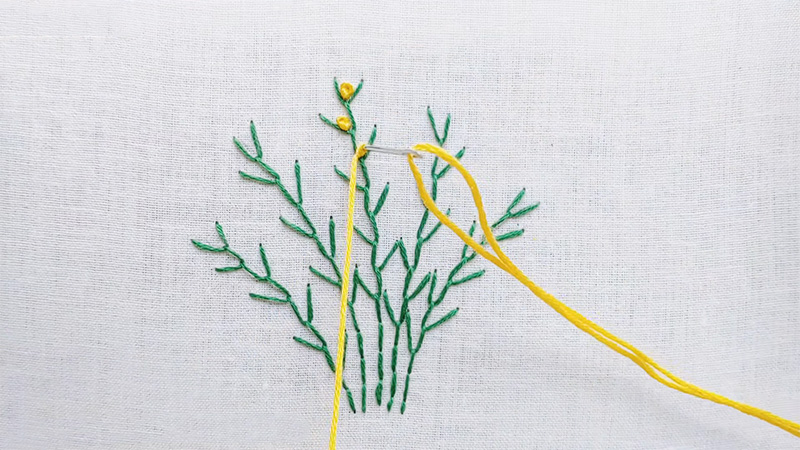Feather stitch embroidery, an art form steeped in tradition, brings together the delicate beauty of nature and the creative expression of human hands.
This elegant and versatile embroidery technique, often celebrated for its resemblance to the graceful plumage of birds, has a rich history that spans cultures and centuries.
Whether used for intricate floral motifs, decorative borders, or elaborate patterns, feather stitch embroidery is a captivating craft that allows artisans to weave their imagination into the fabric.
The essence of feather stitch embroidery lies in the interplay of slanted stitches forming V-shaped motifs. Each stitch delicately overlaps the previous one, creating a mesmerizing, feathery effect.
With a needle, thread, and a dash of creativity, enthusiasts can breathe life into their designs, infusing them with texture, dimension, and a touch of whimsy. This introduction embarks on Feather Stitch Embroidery, exploring its techniques, variations, and enduring appeal.

Feather Stitch Embroidery
Feather stitch embroidery is a beautiful and versatile hand embroidery technique that can be used to create delicate and intricate designs.
Here are the simple methods to master feather stitch embroidery:
Basic Feather Stitch
Begin by bringing your needle up through the fabric and making a small straight stitch. Then, angle your needle to one side and insert it back into the fabric, creating a slanted stitch.
Continue this process, alternating sides, to create a series of V-shaped stitches that resemble feathers. This method is the foundation for all variations of feather stitches.
Closed Feather Stitch
Start with a row of basic feather stitches. After completing one side of the V-shaped stitches, come back along the opposite side, filling in the gaps and creating a closed or solid line of feather stitches.
This technique is perfect for outlining shapes or creating borders.
Open Feather Stitch
Open feather stitch is the opposite of closed feather stitch. Instead of coming back along the opposite side, leave gaps between the V-shaped stitches, giving your embroidery a lacy and open appearance.
This method is great for creating a delicate and airy look in your designs.
Double Feather Stitch
Double feather stitch involves adding an extra straight stitch between each V-shaped stitch. This creates a more defined and textured look. It’s ideal for adding dimension to your embroidery, especially when working on floral motifs.
Cretan Stitch
A Cretan stitch is a variation of feather stitch where the V-shaped stitches are stacked closely together in a zigzag pattern. This creates a textured, braid-like effect. Cretan stitch is often used for decorative borders and edging.
Detached Feather Stitch
In this method, individual feather stitches are worked without connecting them in a continuous line.
Each V-shaped stitch is a standalone unit, allowing for more flexibility in creating unique patterns and designs. The detached feather stitch is perfect for adding details to small areas.
Double Detached Feather Stitch
This technique combines two detached feather stitches side by side, with a small space between them. It results in a decorative and symmetrical pattern.
You can experiment with varying the distance between the stitches to achieve different effects, making it suitable for various embroidery projects.
Feather stitch embroidery offers endless possibilities for creativity and personalization in your handcrafted designs. By mastering these simple methods, you can elevate your embroidery skills and create stunning pieces of artistry.
Type Of Stitch Is Feather Stitch?

Feather stitch is a type of embroidery stitch that creates airy lines of stitching along curves or straight lines. It is one of the most basic and popular embroidery stitches and can be used to create an edge finish or a surface embroidery stitch.
There are many variations of feather stitch, but here are the common ones:
Basic Feather Stitch:
This is the simplest form of feather stitch, where the stitches alternate on each side of the line being worked.
The stitches are made by taking the needle down to the right or left, leaving a loop of thread on the surface, and bringing the needle up below and between the two endpoints of the stitch.
Long-Armed Feather Stitch:
This is a variation of basic feather stitch, where the stitches are longer and more spaced out. The stitches can be made in different lengths to create a more irregular and organic look.
Double Feather Stitch:
This is a variation of basic feather stitch, where two stitches are made on each side of the line instead of one. The stitches can be parallel or crossed over each other to create different effects.
Closed Feather Stitch:
This is a variation of a basic feather stitch, where the stitches meet at the centre line instead of leaving a gap. The result is a series of V-shaped stitches that form a solid line.
Chained Feather Stitch:
This is a variation of basic feather stitch, where a chain stitch is added to each loop of thread on the surface. The chain stitch can be made in the same or different colour as the feather stitch to create contrast3.
Cloud Stitch:
This is a variation of basic feather stitch, where three small straight stitches are added to each loop of thread on the surface. The straight stitches can be horizontal, vertical, or diagonal to create different shapes.
Spanish knotted feather stitch: This is a variation of basic feather stitch, where a knot is added to each loop of thread on the surface. The knot is made by wrapping the thread around the needle twice before pulling it through the fabric.
Common Mistakes People Make While Doing Feather Stitch In Embroidery

Embroidery, including feather stitching, can be a rewarding craft, but it’s not without its challenges.
Here are the common mistakes people make while doing feather stitch in embroidery:
Uneven Stitch Lengths:
One of the most frequent errors is creating uneven stitch lengths. Inconsistencies can make the feather stitch look messy and less polished. Be mindful of maintaining a consistent stitch length for a neater appearance.
Incorrect Angling:
Feather stitch relies on a slanted angle to create its characteristic V-shape. A common mistake is not maintaining the correct angle, which can distort the stitch or make it look irregular. Pay attention to the angle while stitching.
Skipping Stitches:
Skipping stitches, especially when working on long lines, can disrupt the flow of the feather stitch. Always ensure that you make each stitch consistently without gaps.
Incorrect Starting and Ending Points:
If you don’t start or end your feather stitch correctly, it can appear uneven or disjointed. Always start and end at the same height to maintain the stitch’s uniformity.
Uneven Tension:
Inconsistent tension in your thread can result in uneven and puckered stitches. Be mindful of maintaining the same level of tension throughout your embroidery work.
Ignoring Fabric Grain:
Not paying attention to the fabric’s grain can cause your feather stitch to veer off course. Ensure that your stitches follow a straight line parallel to the grain for a professional finish.
Not Securing the Thread:
Failing to secure the thread properly can lead to the unraveling and loosening of your stitches. Always secure your thread at the beginning and end of each stitch.
Using the Wrong Thread:
Choosing the wrong thread can affect the appearance of your feather stitch. Thin or weak threads may not hold up well, while thick threads can create bulky and awkward-looking stitches. Select an appropriate thread for your project.
Ignoring Pattern Flow:
Feather stitches can be used for various patterns and designs. A common mistake is not planning the flow of your stitches, which can result in a design that lacks cohesion. Take the time to sketch out your design and consider how feather stitches will complement it.
By being aware of these common mistakes and practicing your feather stitch embroidery with care and attention to detail, you can improve your skills and create beautiful, flawless designs.
FAQ
What is Feather Stitch Embroidery?
Feather stitch embroidery is a hand embroidery technique characterized by V-shaped stitches that resemble feathers. It’s used for creating decorative lines, borders, and patterns on fabric. This versatile stitch can be adapted to various designs and projects.
What materials do I need for Feather Stitch Embroidery?
To get started with feather stitch embroidery, you’ll need embroidery fabric, an embroidery hoop, embroidery floss or thread, needles, and embroidery scissors. Additionally, a pattern or design, along with an embroidery hoop stand, can be helpful for more complex projects.
Can beginners learn Feather Stitch Embroidery?
Absolutely! Feather stitch embroidery is a beginner-friendly technique. With some practice, anyone can learn to create this elegant stitch. Start with basic feather stitch patterns and gradually progress to more intricate designs as your skills improve.
What are some common variations of Feather Stitch?
Common variations include closed feather stitch (solid lines), open feather stitch (with gaps between stitches), Cretan stitch (zigzag pattern), detached feather stitch (individual stitches), and double feather stitch (adding an extra stitch between Vs). These variations offer versatility for various embroidery projects.
How can I care for Feather Stitch Embroidery projects?
To preserve your feather stitch embroidery, avoid exposing it to direct sunlight for extended periods, as this can cause fading.
When washing, use mild detergents and hand wash gently or place your project inside a pillowcase to protect it in the washing machine. Iron on low heat with a pressing cloth to avoid damaging the stitches.
Conclusion
In the world of textile artistry, feather stitch embroidery stands as a testament to the enduring charm of handcrafted beauty.
Through the careful arrangement of stitches, it transforms fabric into a canvas for storytelling, tradition, and personal expression. As we conclude our exploration of feather stitch embroidery, we celebrate its ability to transcend time and trends.
This timeless craft invites both beginners and experienced embroiderers to embark on a creative journey, one stitch at a time.
Its variations offer a wide spectrum of design possibilities, from the intricate to the whimsical. Whether you’re crafting a vintage-inspired sampler or adorning contemporary fashion, feather stitch embroidery lends a unique touch that is both elegant and enchanting.
As we bid adieu to our embroidery needle and thread, let us remember that this art form not only embellishes fabric but also weaves together the threads of culture, heritage, and imagination.
Leave a Reply